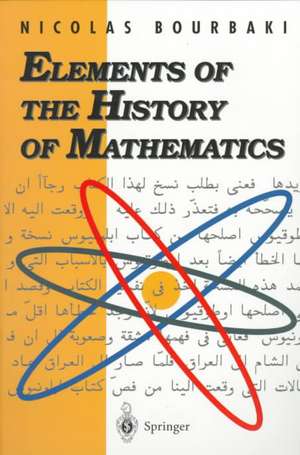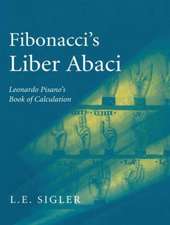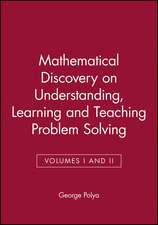Elements of the History of Mathematics
Traducere de J. Meldrum Autor N. Bourbakien Limba Engleză Paperback – 17 noi 1998
Preț: 438.29 lei
Nou
Puncte Express: 657
Preț estimativ în valută:
83.87€ • 91.38$ • 70.67£
83.87€ • 91.38$ • 70.67£
Carte tipărită la comandă
Livrare economică 19-25 aprilie
Preluare comenzi: 021 569.72.76
Specificații
ISBN-13: 9783540647676
ISBN-10: 3540647678
Pagini: 312
Dimensiuni: 155 x 235 x 16 mm
Greutate: 0.45 kg
Ediția:1st ed. 1994. 2nd printing 1998
Editura: Springer Berlin, Heidelberg
Colecția Springer
Locul publicării:Berlin, Heidelberg, Germany
ISBN-10: 3540647678
Pagini: 312
Dimensiuni: 155 x 235 x 16 mm
Greutate: 0.45 kg
Ediția:1st ed. 1994. 2nd printing 1998
Editura: Springer Berlin, Heidelberg
Colecția Springer
Locul publicării:Berlin, Heidelberg, Germany
Public țintă
ResearchDescriere
This
work
gathers
together,
without
substantial
modification,
the
major
ity
of
the
historical
Notes
which
have
appeared
to
date
in
my
Elements
de
M
atMmatique.
Only
the
flow
has
been
made
independent
of
the
Elements
to
which
these
Notes
were
attached;
they
are
therefore,
in
principle,
accessible
to
every
reader
who
possesses
a
sound
classical
mathematical
background,
of
undergraduate
standard.
Of
course,
the
separate
studies
which
make
up
this
volume
could
not
in
any
way
pretend
to
sketch,
even
in
a
summary
manner,
a
complete
and
con
nected
history
of
the
development
of
Mathematics
up
to
our
day.
Entire
parts
of
classical
mathematics
such
as
differential
Geometry,
algebraic
Geometry,
the
Calculus
of
variations,
are
only
mentioned
in
passing;
others,
such
as
the
theory
of
analytic
functions,
that
of
differential
equations
or
partial
differ
ential
equations,
are
hardly
touched
on;
all
the
more
do
these
gaps
become
more
numerous
and
more
important
as
the
modern
era
is
reached.
It
goes
without
saying
that
this
is
not
a
case
of
intentional
omission;
it
is
simply
due
to
the
fact
that
the
corresponding
chapters
of
the
Elements
have
not
yet
been
published.
Finally
the
reader
will
find
in
these
Notes
practically
no
bibliographic
or
anecdotal
information
about
the
mathematicians
in
question;
what
has
been
attempted
above
all,
for
each
theory,
is
to
bring
out
as
clearly
as
possible
what
were
the
guiding
ideas,
and
how
these
ideas
developed
and
reacted
the
ones
on
the
others.
Cuprins
1.
Foundations
of
Mathematics;
Logic;
Set
Theory.-
2.
Notation;
Combinatorial
Analysis.-
3.
The
Evolution
of
Algebra.-
4.
Linear
Algebra
and
Multilinear
Algebra.-
5.
Polynomials
and
Commutative
Fields.-
6.
Divisibility;
Ordered
Fields.-
7.
Commutative
Algebra.
Algebraic
Number
Theory.-
8.
Non
Commutative
Algebra.-
9.
Quadratic
Forms;
Elementary
Geometry.-
10.
Topological
Spaces.-
11.
Uniform
Spaces.-
12.
Real
Numbers.-
13.
Exponentials
and
Logarithms.-
14.
n
Dimensional
Spaces.-
15.
Complex
Numbers;
Measurement
of
Angles.-
16.
Metric
Spaces.-
17.
Infinitesimal
Calculus.-
18.
Asymptotic
Expansions.-
19.
The
Gamma
Function.-
20.
Function
Spaces.-
21.
Topological
Vector
Spaces.-
22.
Integration
in
Locally
Compact
Spaces.-
23.
Haar
Measure.
Convolution.-
24.
Integration
in
Non
Locally
Compact
Spaces.-
25.
Lie
Groups
and
Lie
Algebras.-
26.
Groups
Generated
by
Reflections;
Root
Systems.
Caracteristici
The
book
offers
a
convenient
and
compact
way
of
learning
history
of
several
subfields
of
mathematics
INCLUDING
the
modern
(20th
century)
development
(which
is
not
so
easily
available),
in
an
elegant
and
readable
account
by
some
of
the
leading
contemporary
proponents


















